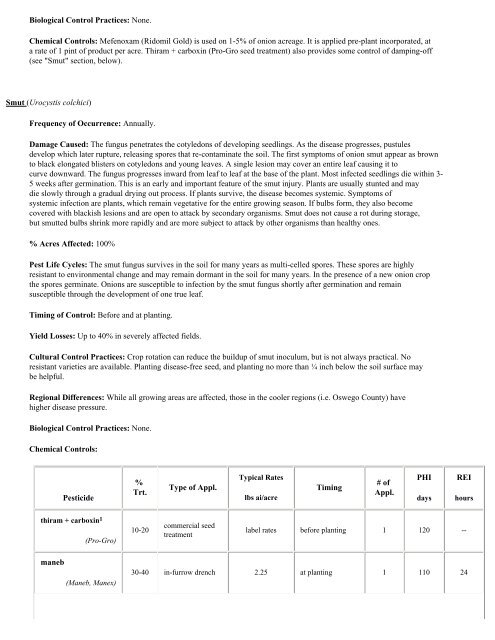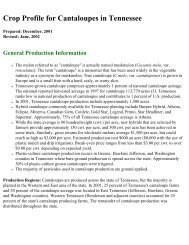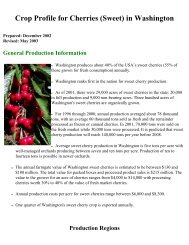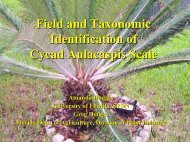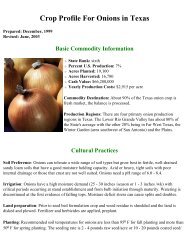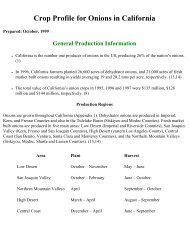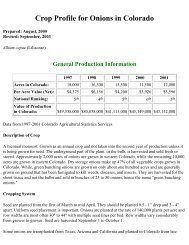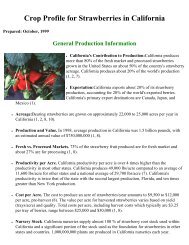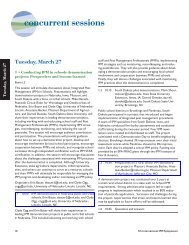Crop Profile for Onions in New York - Regional IPM Centers
Crop Profile for Onions in New York - Regional IPM Centers
Crop Profile for Onions in New York - Regional IPM Centers
Create successful ePaper yourself
Turn your PDF publications into a flip-book with our unique Google optimized e-Paper software.
Biological Control Practices: None.<br />
Chemical Controls: Mefenoxam (Ridomil Gold) is used on 1-5% of onion acreage. It is applied pre-plant <strong>in</strong>corporated, at<br />
a rate of 1 p<strong>in</strong>t of product per acre. Thiram + carbox<strong>in</strong> (Pro-Gro seed treatment) also provides some control of damp<strong>in</strong>g-off<br />
(see "Smut" section, below).<br />
Smut (Urocystis colchici)<br />
Frequency of Occurrence: Annually.<br />
Damage Caused: The fungus penetrates the cotyledons of develop<strong>in</strong>g seedl<strong>in</strong>gs. As the disease progresses, pustules<br />
develop which later rupture, releas<strong>in</strong>g spores that re-contam<strong>in</strong>ate the soil. The first symptoms of onion smut appear as brown<br />
to black elongated blisters on cotyledons and young leaves. A s<strong>in</strong>gle lesion may cover an entire leaf caus<strong>in</strong>g it to<br />
curve downward. The fungus progresses <strong>in</strong>ward from leaf to leaf at the base of the plant. Most <strong>in</strong>fected seedl<strong>in</strong>gs die with<strong>in</strong> 3-<br />
5 weeks after germ<strong>in</strong>ation. This is an early and important feature of the smut <strong>in</strong>jury. Plants are usually stunted and may<br />
die slowly through a gradual dry<strong>in</strong>g out process. If plants survive, the disease becomes systemic. Symptoms of<br />
systemic <strong>in</strong>fection are plants, which rema<strong>in</strong> vegetative <strong>for</strong> the entire grow<strong>in</strong>g season. If bulbs <strong>for</strong>m, they also become<br />
covered with blackish lesions and are open to attack by secondary organisms. Smut does not cause a rot dur<strong>in</strong>g storage,<br />
but smutted bulbs shr<strong>in</strong>k more rapidly and are more subject to attack by other organisms than healthy ones.<br />
% Acres Affected: 100%<br />
Pest Life Cycles: The smut fungus survives <strong>in</strong> the soil <strong>for</strong> many years as multi-celled spores. These spores are highly<br />
resistant to environmental change and may rema<strong>in</strong> dormant <strong>in</strong> the soil <strong>for</strong> many years. In the presence of a new onion crop<br />
the spores germ<strong>in</strong>ate. <strong>Onions</strong> are susceptible to <strong>in</strong>fection by the smut fungus shortly after germ<strong>in</strong>ation and rema<strong>in</strong><br />
susceptible through the development of one true leaf.<br />
Tim<strong>in</strong>g of Control: Be<strong>for</strong>e and at plant<strong>in</strong>g.<br />
Yield Losses: Up to 40% <strong>in</strong> severely affected fields.<br />
Cultural Control Practices: <strong>Crop</strong> rotation can reduce the buildup of smut <strong>in</strong>oculum, but is not always practical. No<br />
resistant varieties are available. Plant<strong>in</strong>g disease-free seed, and plant<strong>in</strong>g no more than ¼ <strong>in</strong>ch below the soil surface may<br />
be helpful.<br />
<strong>Regional</strong> Differences: While all grow<strong>in</strong>g areas are affected, those <strong>in</strong> the cooler regions (i.e. Oswego County) have<br />
higher disease pressure.<br />
Biological Control Practices: None.<br />
Chemical Controls:<br />
Pesticide<br />
thiram + carbox<strong>in</strong> 1<br />
maneb<br />
(Pro-Gro)<br />
(Maneb, Manex)<br />
%<br />
Trt.<br />
10-20<br />
Type of Appl.<br />
commercial seed<br />
treatment<br />
Typical Rates<br />
lbs ai/acre<br />
Tim<strong>in</strong>g<br />
# of<br />
Appl.<br />
PHI<br />
days<br />
REI<br />
hours<br />
label rates be<strong>for</strong>e plant<strong>in</strong>g 1 120 --<br />
30-40 <strong>in</strong>-furrow drench 2.25 at plant<strong>in</strong>g 1 110 24


